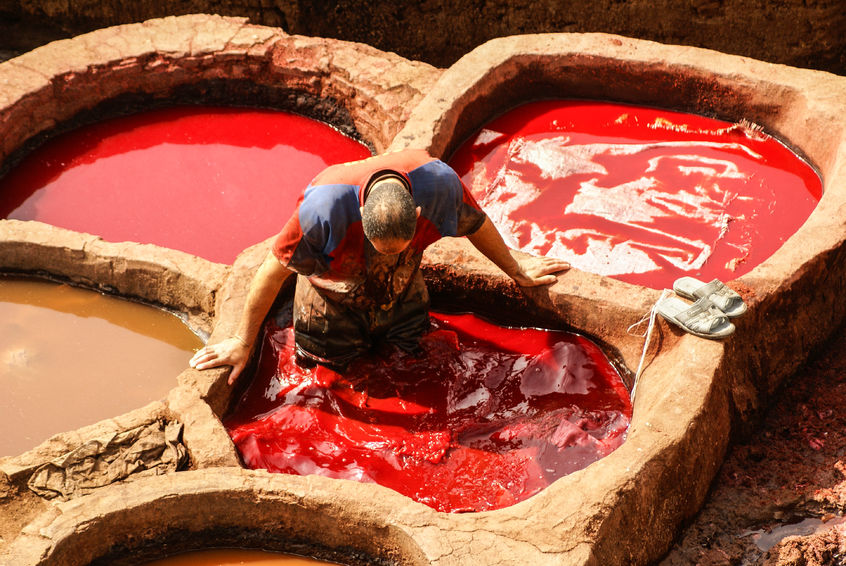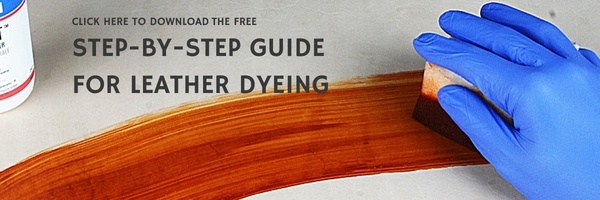Leather dye must have three features to be functional:
- Penetrate inside the leather;
- Impregnate the leather fibers with the coloring substance;
- Keep the molecular structure of the leather unchanged.
Finally, leather dye can also have the ability to donate, to the leather, additional technical characteristics.
1. Leather Penetration:
Natural leather is an organic material with a certain permeability. The first feature that a leather dye must have is the ability to penetrate the outer surface of the leather and reach the underlying fibers, among which the coloring substances will be transported. The penetration inside the leather can be more or less deep. This depends on the type of mixture with which the dye was made. This also depends from the amount of dye applied and how much time the leather stays in contact with the dye.
Generally alcohol or solvents have a great penetration capacity, so they can penetrate inside the leather very quickly even if applied in small quantities, while water-based mixtures have a much slower penetration and to get into the leather they need more quantity and time.
In the history of leather, it was immersed for days and days, in a mixture of water and other
coloring substances, then with the evolution of the tanning industry different types of mixtures
have been introduced to reduce the production time.
These mixtures were also used in the production of dyes for the leather crafting coloration.
The penetration capacity of the leather is given by the type of mixture used. It can be based on alcohol, solvents or water. Its composition determines the depth, time and quantity necessary to achieve penetration.
2. Leather Fibers Impregnation:
To have a good color consistency it is necessary that the leather fibers are impregnated and well fixed with the coloring substance, otherwise during its life the leather will tend to release the coloring substance. Consequently, the leather item will lose the color and what is even more unpleasant, the color can be transferred to other objects that come into contact with it.
The coloring substances are generally inert substances, with no capacity for organic interaction.

One of the variables that can determine a major or minor anchorage of the coloring substance to the leather fiber is its pH. In addition to this, the greater the time for which the dye remains in contact with the leather fiber and the greater will be the fixing. In support of this, resins can be introduced into leather dyes, which amplify the fixing characteristics to the leather fiber, thus reducing the possibility of color rubbing off over time.
Leather fibers impregnation depends on the type of color and the presence of resins inside, this feature determines the level of leather dye transfer that can occur.
3. Keep the molecular structure of the leather unaltered:
Natural tanned leather, whether it is vegetable tanning or chrome tanning, has softness characteristics that are a determining factor in the choice of one leather rather than another. Therefore it is important that these characteristics are kept unaltered during the production phase of a leather item.
The softness or stiffness of a leather is given by the strength with which the fibers of the leather are aligned. This characteristic can be generally modified through a mechanical action (of drumming or stacking) or using specific chemical agents. Usually the leather dyeing process doesn't influence the leather softness.
The feel of the leather is instead a characteristic determined by the presence of moisture and microparticles of water that remain inside the leather once the tanning process has been completed. This feature can be modified by the leather coloring process. In fact, a leather dye that evaporates too quickly could drag a part of the residual moisture to the outside of the leather, with a consequent dryness of the leather.
The softness is generally not influenced by the leather dyeing, while paints with too rapid drying (for example mixtures with high percentages of alcohol) can cause a dryness of the leather.
3+1. Increase the leather technical features:
The leather finishing process does not usually stop at coloring, but can include further steps to give the leather more features such as increasing its impermeability, changing its feel, shine and so on.
Some of these additional features can be introduced into the leather during the coloring process itself, thus avoiding having to resort to additional finishing steps.
For example, in leather dyeing, oils, greases or waxes can be added to give the dye additional technical features, these additional components must however always be balanced in the right doses, otherwise we can risk losing more important features.
The leather dye is therefore a mixture that must have the right balance between its components in order to have characteristics suitable to its use and to the desired result.



